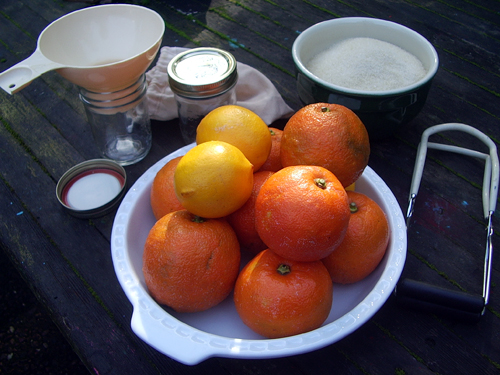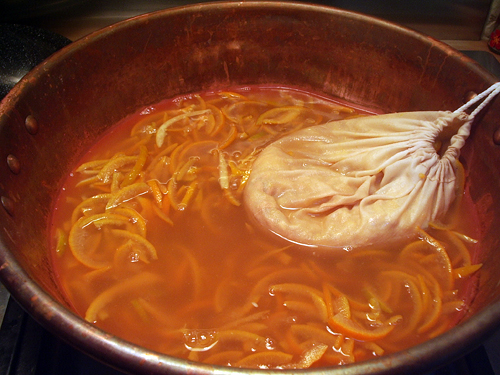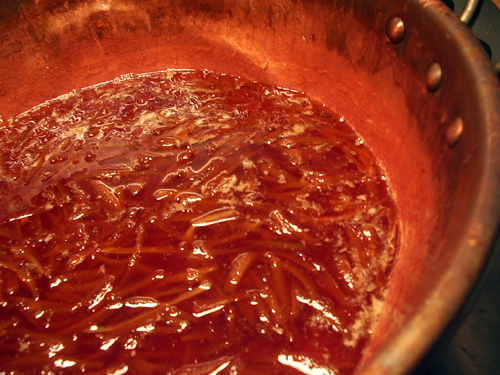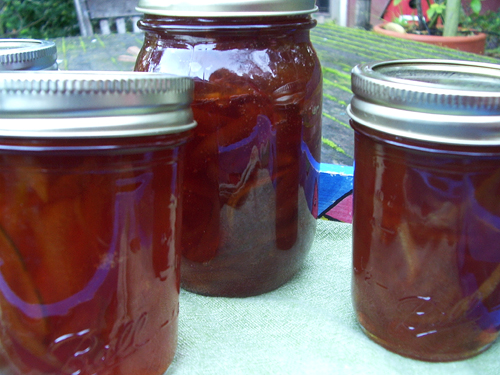But what is marmalade, anyway, and how is it different from jelly or jam? First off, it's made from citrus, traditionally oranges but potentially any kind or combination of citrus fruit, from Rangpur limes to grapefruits. Unlike jelly, made from juice only, or jam, made from crushed fruit (or fruits) with all their juice, marmalade is made from the juice, pulp, and peel of citrus fruits, cooked with sugar and (usually) water. The peel may not always be visible in the finished product (it can be strained out for clarity after cooking), but the fragrant oils in the peel are what gives marmalade its unique flavor. Without peel, you'd just have orange jelly.
As noted earlier, you can make marmalade with just about any citrus fruit. But true-blue British marmalade lovers know that the most classic marmalade is made from just one fruit: the Seville orange, a knobbly, seedy, green-patched fruit cultivated not for its scant and sour juice but for its ravishingly aromatic peel. These Spanish-born oranges, which make a marmalade of rich complexity, were for a long time the only oranges used for marmalade in Britain. (For a deep and fascinating dive into the centuries-old history of British preserving, C. Anne Wilson's The Book of Marmalade is a must-read.) I've made numerous marmalades over the years, and nothing compares in depth and intrigue to one made with Sevilles.
Local jam makers like June Taylor do make wonderful marmalades, but alas, the high price of those itty-bitty jars can be prohibitive to a daily toast habit. Anyway, aren't we all making our own now? Making homemade marmalade can be a sticky business, but one cold afternoon's worth of effort can produce months of happy mornings. And if you have any oranges left over, you can make duck à l'orange, or the tangy, garlicky Cuban marinade known as mojo.

Seville oranges, lemons, sugar, and equipment (from left: jar lid, jars, wide-mouth funnel, muslin bag, jar lifter tongs)
Now is the time to find Seville oranges: they have only a brief winter season, and are grown on only the smallest commercial scale even in California. The only grower I've found with a steady supply of Sevilles in season is the DeSantis Farm from the Central Valley. They sell these and many other beautiful specialty varieties at the Alemany Farmers' Market on Saturdays, the Marin Civic Center market on Thursdays and Sundays, and the Heart of the City Farmers' Market on Wednesdays.
A warning: don't buy anything unless it's clearly marked and sold as a Seville orange. Unless they work for an orchard specializing in odd varieties of citrus, like Buddha's Hand or bergamot, few farmers' market sellers will have any idea what a Seville orange is. Just asking for Sevilles, or for good marmalade oranges, isn't enough; sellers are in the business of selling, and the easiest way to deal with a customer's weird request is simply to sell her whatever's already on the table, be it a navel or a satsuma. Currently, both Berkeley Bowl and Bi-Rite Market have Seville oranges for sale, for $1.69/lb and $3.99/lb, respectively.
If you make jam on any kind of a regular basis, you should already have the basic gear: a scale, a wide-mouth funnel, a jar lifter, a bunch of canning jars, and a wide, heavy pot for cooking. If not, make the small investment and go to the hardware store and at least get the scale and the jar lifter. Trying to wrestle slippery hot jars in and out of a potful of boiling water with a pair of tongs is a crazy-making endeavor, trust me. And to measure fruit and sugar accurately, you really do need a small, preferably digital kitchen scale, available at any well-stocked kitchen-supply or hardware store.
Something else to know about marmalade: sometimes, you do everything right, and it doesn't seem to gel up. Don't despair, and don't cook it to death trying to get it to thicken. Once you've added the sugar, cooking it longer (say, more than an hour) won't always give you better results. Overly long cooking can break down the pectin and/or caramelize the sugar, giving a heavier, darker taste that's not so bright and citrusy.
If everything else about it seems right, jar it up and put it away for a week or two. I've had this happen to me--imagining that I'll have to re-open the jars and try boiling down the whole mess a second time--only to find that, left to its own devices for a while, the marmalade has gelled up perfectly all by itself. It happens. So, don't despair right away.
Seville Orange Marmalade
Particularly heavenly with hot tea and toast made from last year's recipe for Easy Multi-Grain Bread.
Makes: 8 half-pint jars
Ingredients:
3 lbs Seville oranges, approximately 8-10 oranges
2 lemons
2 quarts plus 1 cup water
3 lbs granulated sugar, preferably the pale-blond, organic kind
Special Equipment:
- small muslin jelly bag or 8"x8" doubled square of cheesecloth
- wide-mouth funnel
- jar-lifting tongs
- 8 half-pint canning jars or 4 pint canning jars, with metal rings and flat lids
- a wide, heavy, non-reactive pot, such as copper, stainless steel, or enameled cast iron
- a tall, deep pot
- candy thermometer (optional)
- a few saucers, in the freezer
Preparation:
1. Wash oranges and lemons well. Halve fruit and squeeze juice into a bowl. Pour the juice through a strainer, and drop the seeds into a separate bowl.
2. Using your fingers, and possibly a serrated-edged grapefruit spoon if necessary, pull out the remaining pulp, seeds, and membrane from inside the fruit halves. Using the spoon, scrape out as much white pith from the inside of the fruit halves as you can. Put the pulp, seeds, membrane and pith into the bowl of seeds.
3. Cut the now-scraped halves into quarters. If you have a food processor, shred the quarters using the slicing disk. Otherwise, use a mandoline or a very sharp knife to slice the peel into fine strips.
4. Scoop the pulp, pith, and seeds into a muslin bag or a square of cheesecloth. Tie the bag shut, or knot the pointed ends of the cheesecloth square together firmly.

5. Pour the juice, water, and shredded peel into a large, heavy pot. Add the bag of pulp. Bring to a simmer over medium-low heat. Cover and let simmer gently for about an hour, until peel is very tender.
6. Remove pot from heat. Lift out bag, put it in a bowl and let cool for 15 or 20 minutes, until it can be comfortably handled.
7. While bag is cooling, add sugar to pot, stirring until dissolved and mixture is clear.
8. When bag is cool enough to handle, hold bag over the pot and squeeze firmly to get all the liquid out. Yes, it will feel slimy; this is a good thing. That slimy-feeling stuff is the natural pectin present in the seeds and membranes, and it's what will make your marmalade gel.

9. Bring pot to a fierce boil, stirring frequently to make sure it doesn't burn or stick. It should reach the setting point in about 20-30 minutes. Visually, it should look dark amber in color, with a maple-syrupy consistency. The peels should look thinned down and translucent.
To check the set:
- Use a candy thermometer. The setting point should be reached around 220 degrees F. Or,
- Remove pot from heat. Take a saucer out of the freezer and drop a spoonful onto the saucer. Return it to the freezer for a minute or two. Push the spoonful of marmalade with your finger. If it feels like warm honey and sets in one place rather than running all over the saucer, it's done. If not, return pot to heat and cook, stirring, for a few more minutes, then test again. Don't expect it to be as thick as store-bought marmalade at this point; it won't fully gel up until cold.
10. Let the marmalade sit for 30 minutes, in order to keep all the peel from floating up to the top of the jars. Meanwhile, fill a large, deep pot with hot water. Sink jars into the water--they should be covered by at least an inch. Bring to a boil and simmer for 10 minutes to sterilize jars.
11. Lift jars out of the pot. Using a ladle and a wide-mouthed funnel, fill jars to within 1/4" inch of the rim. Wipe rim with a wet paper towel or clean dish towel dipped in hot water. Top with flat lid. Screw on ring finger-tight.
12. Replace jars in pot of hot water. Bring pot to a boil and simmer for 8 minutes. Cover a tray or nearby counter with a clean, dry dishtowel. Lift jars out of hot water and let cool completely on towel. Don't disturb the jars while they're cooling. As they cool, you should hear a sharp popping noise from each jar as it seals.
13. When jars are completely cool, check lids for seal by pressing in the middle of lid. Lid should not move. If lid pops up and down, it didn't seal. Store any unsealed jars in the refrigerator and eat within a month.



